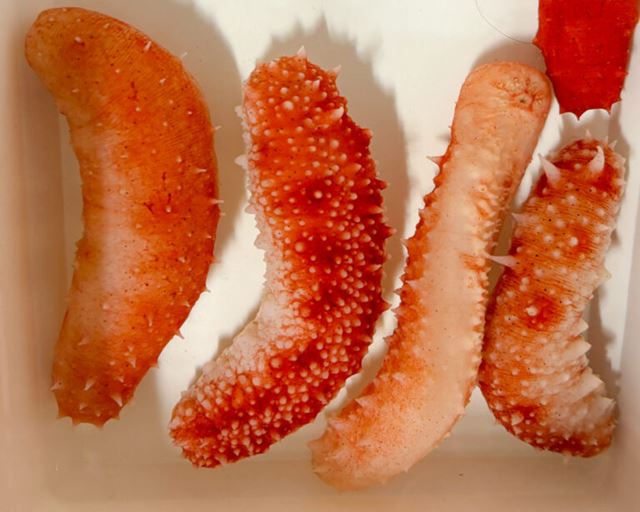Researchers have been working to crack this code for more than three years. Both sexes look identical, so it isn’t easy to tell the males from the females. The researchers were very pleased when they succeeded in getting both sexes to spawn at the same time.
“This is the first stage on our journey towards success in farming this species”, says Senior Research Scientist Jan Ove Evjemo at SINTEF, who conducts his research in the field of new biomarine resources.
These sea cucumbers come in an appetising red colour. They thrive best with their spines erect and can eject parts of their gut when threatened. But don’t worry – they can regenerate a new digestive tract after a short time.

Here are some of the sea cucumbers that live in the lab at SINTEF Ocean. Researchers are hoping that there will soon be many more. Photo: Henriette Krogness
Little known red delicacy
Sea cucumbers are a common dish in China and other parts of Asia, where they are regarded as nothing less than a delicacy. They have been described as the ‘ginseng of the sea’. In their dried form they can cost more than NOK 5,000 per kilo. However, it is not the red sea cucumber that is eaten as a delicacy in Asia. In fact, we know more or less nothing about the red species that lives in Norwegian waters. This is why researchers at SINTEF are very pleased to be finding out more about this species, which thrives best at great depths.
“It is gratifying also because globally, sea cucumbers are very vulnerable to overfishing”, says Andreas Hagemann, who is a Senior Research Scientist at SINTEF Ocean. “Success in farming this fascinating species may make an important contribution towards conserving wild populations”, he says.
Science has identified more than 1,700 species of sea cucumber, and while some thrive in sea water at 20 degrees, others prefer temperatures of four degrees. For this reason, research results from species at one location in the world will not necessarily be transferable to those elsewhere.
Getting red sea cucumbers to spawn in the lab has not been an easy task. But even more knowledge is needed if Evjemo, Hagemann and their colleagues are to succeed in coaxing eggs into adult individuals. Factors such as temperature, water quality, nutrient levels and light conditions have to be right on the button.
“However, we have now achieved a key milestone on our journey”, says Evjemo. “We believe that in the future, sea cucumbers can be an important addition to Norwegian restaurant menus. And perhaps we are seeing a new aquaculture species for the long term”, he says.
Evjemo was the man in the right place at the right time to capture the ‘spawning event’ on film. Enjoy.


